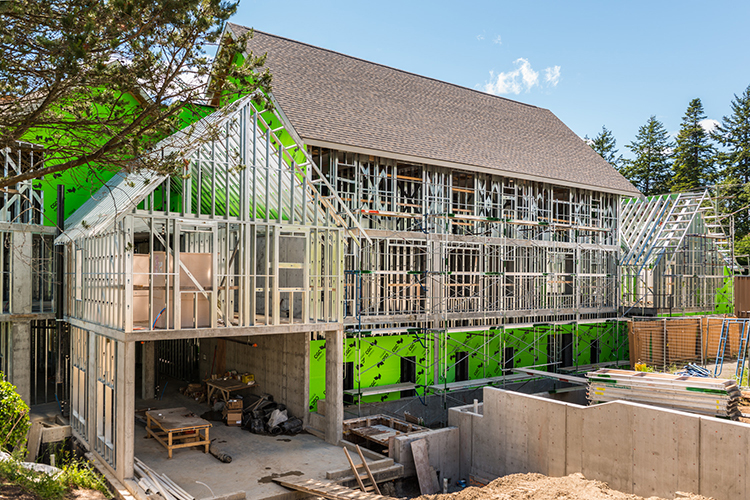Cold-Formed Steel Can Improve Building Occupant Health and Well-being

How Cold-Formed Steel Framing Can Help Prevent Mold
Mold growth can be a serious concern for owners and tenants in older buildings — and for good reason. Mold is known to contribute to a variety of health-related issues. What’s discussed less frequently, however, is that mold growth isn’t limited to older buildings. New construction can harbor potentially harmful fungi, too.
To keep future building occupants safe, it’s important to consider the possibility of mold from the beginning of your project and choose a construction material that can help guard against it, such as cold-formed steel (CFS) framing.
Cause for Concern
Molds are types of fungi that release spores into the air to reproduce. When mold spores find the right conditions — dampness, oxygen, and an organic source to feed on — they grow. There are 1,000 species of mold in the United States, and mold can be found in every environment, both indoors and outside.
Mold spores in the air can be inhaled and, considering Americans spend 90 percent of their time indoors, exposure to mold in enclosed spaces is a valid cause for concern.
Molds are known producers of allergens and irritants. Mold exposure can negatively affect the eyes, skin, nose, throat, and respiratory systems in people with mold allergies and may spur asthma attacks for those with asthma. According to the Center for Disease Control (CDC), if mold is identified on materials, appropriate remediation guidelines with proper containment should be used to minimize exposure to building occupants. Taking measures to limit mold in the first place can raise indoor environmental quality and improve building occupant health and wellbeing.
How Mold Infiltrates Buildings
Building materials that remain wet for more than 48 hours, accompanied by moderate indoor temperatures, create ideal conditions for mold to proliferate. Building materials can become moist through leaking pipes or roofs, rainwater seepage, flooding, uncontrolled high relative humidity, and construction practices that don’t properly protect building materials from the elements.
While water intrusion may be easily identified on some interior surfaces, other building materials, such as wood members and wood framing hidden behind finish materials, may harbor undetected mold. Eventually, mold can eat away at building materials, affecting their look and smell. It can rot wood members and impact the structural integrity of wood-framed buildings.
CFS framing can combat this slow destruction because steel is not organic matter. That makes it an unappealing surface for mold to establish itself and grow.
In addition, CFS won’t warp or sag. Other materials may “creep” over time, twisting, expanding, or contracting with moisture content. These changes can loosen the building frame or allow cracks to develop. When this happens, doors and windows may no longer close properly, which can allow moisture inside. Using CFS, which remains straight and true, can minimize this issue.
Why Mold is a Concern Even in New Buildings
Leaks and aging water-barrier measures are commonly associated with older buildings, but more modern changes in building codes and development practices have provided places for mold to grow, too. Energy efficiency measures, introduced to the construction market in the 1970s, demand building envelopes that are more tightly sealed. Because low ventilation rates don’t provide adequate air circulation and condensation control in these tightly sealed buildings, moisture vapor indoors can become concentrated and create breeding grounds for mold.
In addition, climatic events such as floods, hurricanes, and droughts are frequently associated with extreme temperatures, and these severe environmental changes can lead to mold and envelope degradation in newer buildings.
Even the progressive approach of green building design and construction does not guarantee that buildings are immune to mold. In 2015, it was discovered that the state-of-the-art Mark Twain Museum in Hartford, Connecticut, suffered from mold infestation, despite being the nation’s first LEED (Leadership in Energy and Environmental Design)-certified museum in 2003. Geothermal system problems and a leaking roof brought mold remediation costs to $1 million.
In fact, some debate that certain sustainable practices such as the use of newer, unproven materials can create conditions that allow moisture infiltration to wreak havoc. And in regions of high heat and humidity, the movement to increase ventilation by bringing more outdoor air into a building directly correlates to moisture problems during humid summers.
Preventing all moisture intrusion is virtually impossible regardless of whether buildings are old or new, but CFS can help lessen buildings’ vulnerability to mold. Ventilation can be efficiently built into the design of CFS-framed buildings, and energy efficiency is maintained or increased due to its inorganic properties. In addition, moisture cannot seep into CFS members, offering additional protection against mold growth.
Left to thrive, mold can result in long-term issues that are expensive to repair, impact occupant wellbeing, and even lead to structural deterioration. Thanks to its high resistance to mold, CFS is an excellent choice to construct a durable, long-lasting building.